The Food Holding and Warming Equipment Market is estimated to be valued at USD 5.2 billion in 2025 and is projected to reach USD 7.2 billion by 2035, registering a compound annual growth rate (CAGR) of 3.2% over the forecast period.
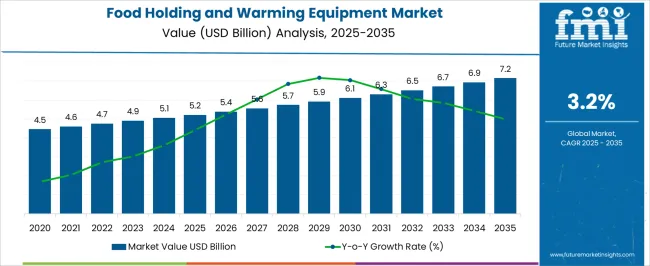
| Metric | Value |
|---|---|
| Food Holding and Warming Equipment Market Estimated Value in (2025 E) | USD 5.2 billion |
| Food Holding and Warming Equipment Market Forecast Value in (2035 F) | USD 7.2 billion |
| Forecast CAGR (2025 to 2035) | 3.2% |
The food holding and warming equipment market is expanding steadily as foodservice operators prioritize product quality, safety, and customer satisfaction. Rising demand from quick service restaurants, catering services, and institutional kitchens has increased the need for reliable equipment that maintains optimal food temperature without compromising freshness.
Innovations in energy efficiency, digital temperature control, and modular equipment design are enabling operators to improve kitchen productivity while adhering to evolving food safety standards. The shift toward takeaway and delivery services has further elevated the importance of holding and warming solutions that preserve product integrity during extended service windows.
Additionally, heightened awareness of energy conservation and sustainability is driving investments in equipment built with advanced insulation materials and eco-friendly heating technologies. The overall outlook is promising, with strong adoption across both commercial and institutional foodservice segments that continue to seek efficiency, consistency, and regulatory compliance.
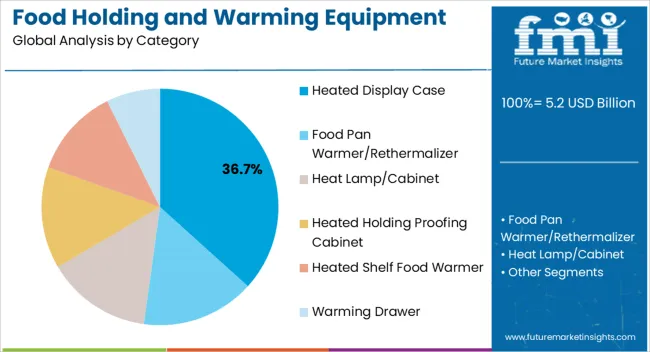
The heated display case category segment is projected to represent 36.70% of total revenue by 2025, positioning it as the leading category. Growth has been supported by increasing demand for ready to eat food options and the need for visually appealing presentation that attracts consumers in retail and foodservice settings.
These cases provide a dual advantage by maintaining proper food temperature and enhancing product visibility, which boosts impulse purchases and customer engagement. The ability to accommodate a wide variety of food products, combined with energy efficient designs and easy maintenance, has further strengthened their adoption.
As consumer preference for hot grab and go meals rises, heated display cases are set to remain dominant within the category segment.
The global demand for food holding and warming equipment is projected to increase at a CAGR of 2.1% during the forecast period between 2020 and 2025, reaching a total of USD 7.2 billion in 2035.
According to Future Market Insights, a market research and competitive intelligence provider, he food holding and warming equipment market was valued at USD 5.2 billion in 2025.
The increasing trend of food trucks, pop-up restaurants, and other mobile foodservice providers has created a need for portable and compact food holding and warming equipment.
The businesses require equipment that is easy to transport and set up, as they operate in diverse locations, which has led to the development of innovative and compact food holding and warming equipment, such as countertop food warmers, portable food warmers, and insulated delivery bags.
The equipment are designed to provide efficient food warming and holding solutions in a compact and portable form, which is highly convenient for mobile foodservice providers.
The equipment are designed to be energy-efficient, durable, and easy to clean, making them a cost-effective solution for small businesses. The demand for portable and compact food holding and warming equipment is expected to increase, as the number of mobile foodservice providers continues to grow.
Rising Popularity of Take-Out and Delivery Services to Fuel the Market Growth
The foodservice industry has witnessed a significant rise in the popularity of take-out and delivery services, particularly in the wake of the COVID-19 pandemic.
The increasing trend towards food delivery has led to a growing demand for food holding and warming equipment to ensure that the food remains hot and fresh during transit. Customers expect their food to be delivered quickly and at the right temperature, which has prompted restaurants and foodservice providers to invest in efficient and reliable food holding and warming equipment.
Food holding and warming equipment, such as heated cabinets, warmers, and holding shelves, are designed to keep food at the optimal temperature and quality until it is ready to be served or delivered.
The equipment types provide consistent heat and maintain a precise temperature range, ensuring that the food stays fresh and hot for extended periods. There has been a significant growth witnessed in the food delivery services, which creates a need for the foodservice providers to rely on equipment that can preserve the quality and safety of their food, and investing in food holding and warming equipment is one way to achieve this.
The rise of third-party delivery services has intensified the competition in the food delivery market. Restaurants and foodservice providers need to ensure that their food is delivered at the right temperature and quality to remain competitive.
Food holding and warming equipment provides a solution to this challenge, helping foodservice providers maintain their food quality and safety standards while catering to the growing demand for delivery services.
Integration of Advanced Technologies such as IoT to Accelerate the Market Growth
The integration of advanced technologies, such as IoT-enabled sensors and cloud-based monitoring systems, is a significant trend that is anticipated to augment the growth of the food holding and warming equipment market.
These technologies enable better temperature control, food safety monitoring, and real-time data analysis, which can help improve operational efficiency and reduce food waste.
IoT-enabled sensors can be used to monitor the temperature of food in real-time, ensuring that it remains at a safe and consistent temperature. The sensors can also alert operators if the temperature goes above or below the desired range, allowing them to take immediate action to prevent spoilage and ensure food safety.
Cloud-based monitoring systems can be used to remotely monitor food holding and warming equipment from any location, which enables foodservice providers to keep track of temperature, humidity, and other important factors that can affect food quality and safety.
Cloud-based monitoring systems can also provide real-time data analysis, enabling operators to identify and address any issues before they become serious problems.
High Cost of Food Holding & Warming Equipment to Restrain the Market Growth
The high cost of food holding and warming equipment can be a significant barrier for businesses to adopt such equipment, particularly for small businesses and startups.
The cost of equipment is a major concern for businesses, as it can significantly impact their profit margins. For small businesses, in particular, investing in expensive equipment can be a risky decision, as they may not have the resources to absorb the cost if the investment does not yield the expected returns.
Businesses may be hesitant to invest in expensive equipment if they do not anticipate a high enough return on investment or if they are unsure about the longevity of their business. The decision to invest in equipment depends on several factors, including the business's financial position, its growth projections, and its target market.
The high cost of equipment can also be a barrier to entry for new players in the market. Startups and small businesses may find it challenging to enter the market due to the high cost of equipment, which can limit their ability to compete with established players. The market, as a result may be dominated by a few large players, limiting competition and innovation in the industry.
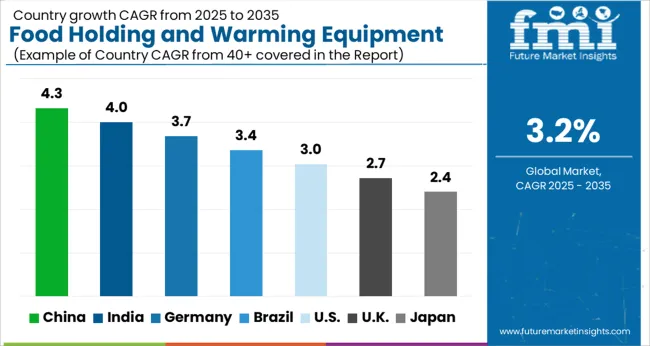
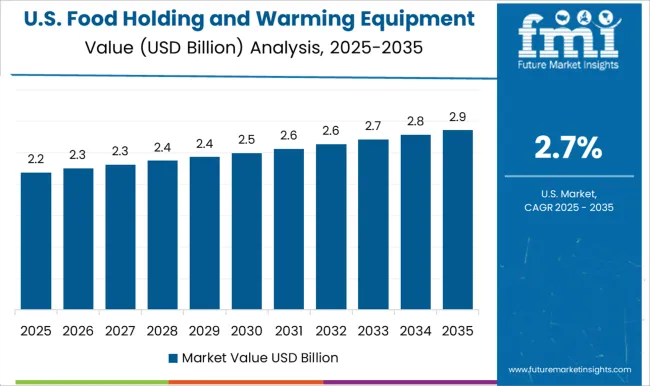
The food holding and warming equipment market in North America is expected to accumulate a prominent CAGR of 3.1% in 2025.
The regional market growth is attributed to the increasing demand for convenience and on-the-go food options. Restaurants and foodservice providers need to ensure that their food remains at the desired temperature during transport and delivery, as more consumers opt for take-out and delivery services, which is expected to drive the demand for food holding and warming equipment in the region.
The foodservice industry in North America, particularly in the United States and Canada, is witnessing a significant surge in the number of restaurants, cafes, and catering services. The surge has led to an increased demand for food holding and warming equipment that can efficiently maintain food quality and safety while keeping it at the appropriate temperature.
The growing emphasis on sustainability and energy efficiency has also become a significant driving factor for the regional market. Manufacturers are introducing equipment that not only reduces energy consumption but also minimizes the environmental impact of their products.
The trend has caught the attention of environmentally-conscious customers who prioritize sustainability, thereby boosting the market growth in the region.
The adoption of advanced technologies, including IoT-enabled sensors and cloud-based monitoring systems, is expected to contribute to the market's growth in North America.
The innovative technologies enable precise temperature control, real-time food safety monitoring, and data analysis, which improve operational efficiency and minimize food waste. More businesses, as a result are likely to adopt these cutting-edge technologies, propelling the market growth in the region.
Increasing Popularity of Online Food Delivery in the Region to Fuel the Market Growth
The food holding and warming equipment market in Asia Pacific is expected to accumulate the highest CAGR of 3.0% in 2025.
The growth of the regional market is attributed to the increasing urbanization and changing lifestyle patterns of consumers. People are more likely to eat out or order in, as they move to urban areas and lead busy lives, creating a higher demand for foodservice establishments and equipment that can meet their needs.
The growing middle-class population in the region, particularly in India and China, has led to an increase in disposable income, allowing consumers to spend more on dining out and high-quality food, further boosting the demand for food holding and warming equipment.
The rising popularity of online food delivery services is also driving the demand for food holding and warming equipment in Asia Pacific. The increasing number of people ordering food online has led to a surge in demand for equipment that can keep food hot during transport and delivery, ensuring that it arrives at the customer's doorstep at the desired temperature.
The increasing focus on food safety and hygiene is another factor accelerating the regional market growth.
Foodservice providers need to ensure that their equipment meets stringent hygiene standards, as consumers become more aware of food safety concerns, which can lead to increased adoption of advanced equipment that features easy-to-clean surfaces and other hygiene-focused features.
Heated Display Case Segment to beat Competition in Untiring Market
On the basis of category, the market is dominated by heated display case segment, which is expected to hold a CAGR of 3.1% over the analysis period.
The major factor that is expected to fuel the segmental growth includes the increasing demand for visually appealing food displays in restaurants and supermarkets. The growing popularity of self-service food displays, especially in supermarkets and convenience stores, is also contributing to the demand for heated display cases.
Heated display cases are designed to maintain the temperature of hot foods and keep them fresh for longer periods, while also showcasing them in an attractive manner. The convenience offered by these display cases to customers in selecting their preferred food items also plays a crucial role in boosting the segmental growth.
The growing trend of on-the-go meals and snacks is also propelling the demand for food holding and warming equipment in the hotel and food court segments. Quick service restaurants, cafes, and bakeries are also adopting advanced equipment to ensure food quality and safety, which is driving the growth of the food holding and warming equipment market in these segments.
Restaurants Segment to Drive the Food Holding and Warming Equipment Market
Based on the Application, the Restaurants segment is expected to expand at rapid rate of 3.0% CAGR over the analysis period.
One major factor contributing to the segmental growth is the increasing number of restaurants globally, coupled with the growing demand for food delivery services. The need for efficient equipment to maintain the quality and safety of food, as well as comply with food safety regulations, is further propelling the growth of this segment.
The rising popularity of fast-food chains and the need for quick service also contribute to the growth of the restaurants segment in the food holding and warming equipment market.
The growing trend of eating out and socializing in restaurants and cafes is driving the demand for food holding and warming equipment in this segment. The need for quality and hygienic food becomes crucial, as more people prefer to dine outside, which is expected to bolster the demand for advanced equipment.
Food holding and warming equipment market startup players are adopting various marketing strategies such as new product launches, geographical expansion, merger and acquisitions, partnerships and collaboration to identify the interest of potential patients and create a larger customer base. For instance,
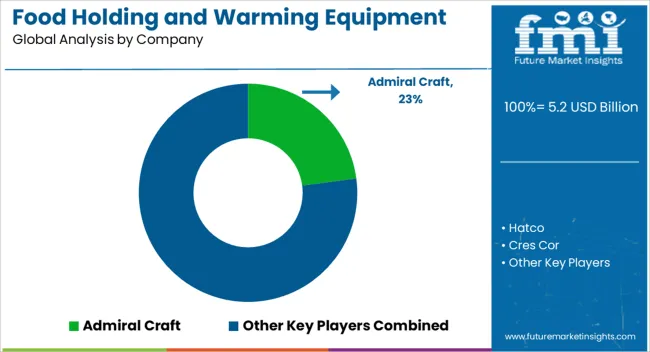
Prominent players in the food holding and warming equipment market are Admiral Craft, Cambro Manufacturing, The Middleby Corporation, Hatco, Cres Cor, Raulsen, True Manufacturing, Turbo Air, Vollrath, Welbilt Inc., Vulcan, Winco, Alto-Shaam, Avantco Equipment, among others.
Recent Developments:
| Report Attribute | Details |
|---|---|
| Growth Rate | CAGR of 3.2% from 2025 to 2035 |
| Market Value in 2025 | USD 5.2 billion |
| Market Value in 2035 | USD 7.2 billion |
| Base Year for Estimation | 2025 |
| Historical Data | 2020 to 2025 |
| Forecast Period | 2025 to 2035 |
| Quantitative Units | Revenue in USD billion and CAGR from 2025 to 2035 |
| Report Coverage | Revenue Forecast, Company Ranking, Competitive Landscape, Growth Factors, Trends, and Pricing Analysis |
| Segments Covered | Category, Installation Type, Material Type, Display Rack Type, Application |
| Regions Covered | North America; Latin America; Europe; Asia Pacific; Middle East & Africa |
| Key Countries Profiled | Germany, United Kingdom, France, Spain, Italy, Rest of Europe, United States, Canada, Brazil, Mexico, India, China, Japan, South Korea, Singapore, Thailand, Indonesia, Australia, New Zealand, Rest of Asia Pacific |
| Key Companies Profiled | Admiral Craft; Hatco; Cres Cor; Raulsen; True Manufacturing; Turbo Air; Vollrath; Vulcan; Winco; Alto-Shaam; Avantco Equipment |
| Customization & Pricing | Available upon Request |
The global food holding and warming equipment market is estimated to be valued at USD 5.2 billion in 2025.
The market size for the food holding and warming equipment market is projected to reach USD 7.2 billion by 2035.
The food holding and warming equipment market is expected to grow at a 3.2% CAGR between 2025 and 2035.
The key product types in food holding and warming equipment market are heated display case, food pan warmer/rethermalizer, heat lamp/cabinet, heated holding proofing cabinet, heated shelf food warmer and warming drawer.
In terms of installation type, undercounter segment to command 54.2% share in the food holding and warming equipment market in 2025.
Explore Similar Insights

Thank you!
You will receive an email from our Business Development Manager. Please be sure to check your SPAM/JUNK folder too.
Chat With
MaRIA